Case Study: Understanding and Managing Challenging Behaviors in Autism
VerifiedAdded on 2022/10/10
|10
|2638
|146
Case Study
AI Summary
This case study examines the challenging behaviors of an autistic teenager, focusing on the context of autism spectrum disorder. The assignment begins with background information on autism, including its characteristics and prevalence, and how these characteristics relate to the case study. The case study details the teenager's behaviors, such as mood swings, physical aggression, and avoidance of tasks. The assignment then explores the functions of these behaviors, primarily linking them to the need for attention and difficulties in social communication. SMART goals are established for the teenager, covering specific, measurable, attainable, reliable, and time-bound objectives. The assignment also proposes proactive interventions, like providing rest during tasks, and reactive interventions, such as offering drinks during tantrums. The study emphasizes the importance of providing care and support, and the need for tailored interventions to improve the teenager's quality of life. References to relevant research articles are included to support the analysis and recommendations.
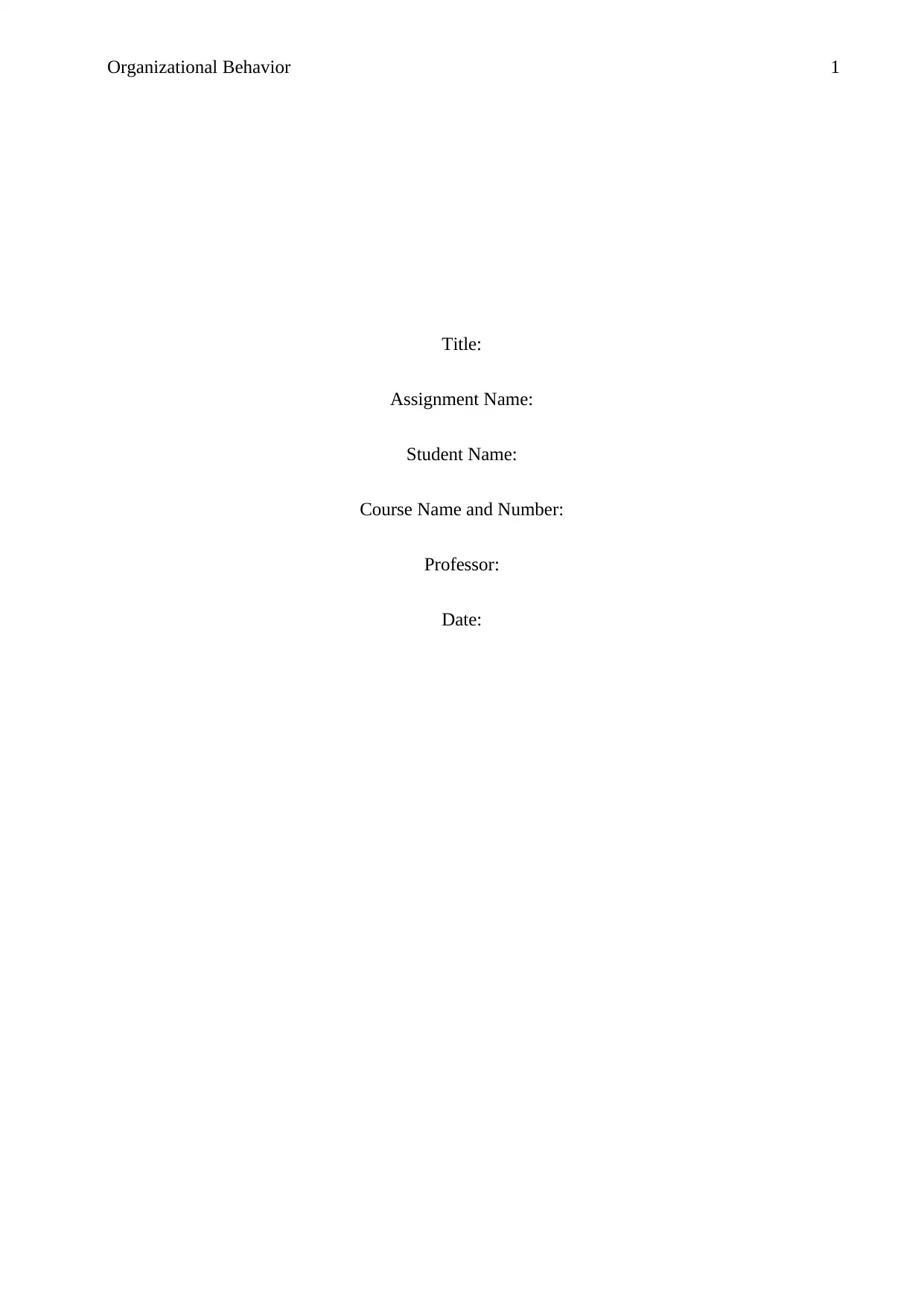
Organizational Behavior 1
Title:
Assignment Name:
Student Name:
Course Name and Number:
Professor:
Date:
Title:
Assignment Name:
Student Name:
Course Name and Number:
Professor:
Date:
Paraphrase This Document
Need a fresh take? Get an instant paraphrase of this document with our AI Paraphraser
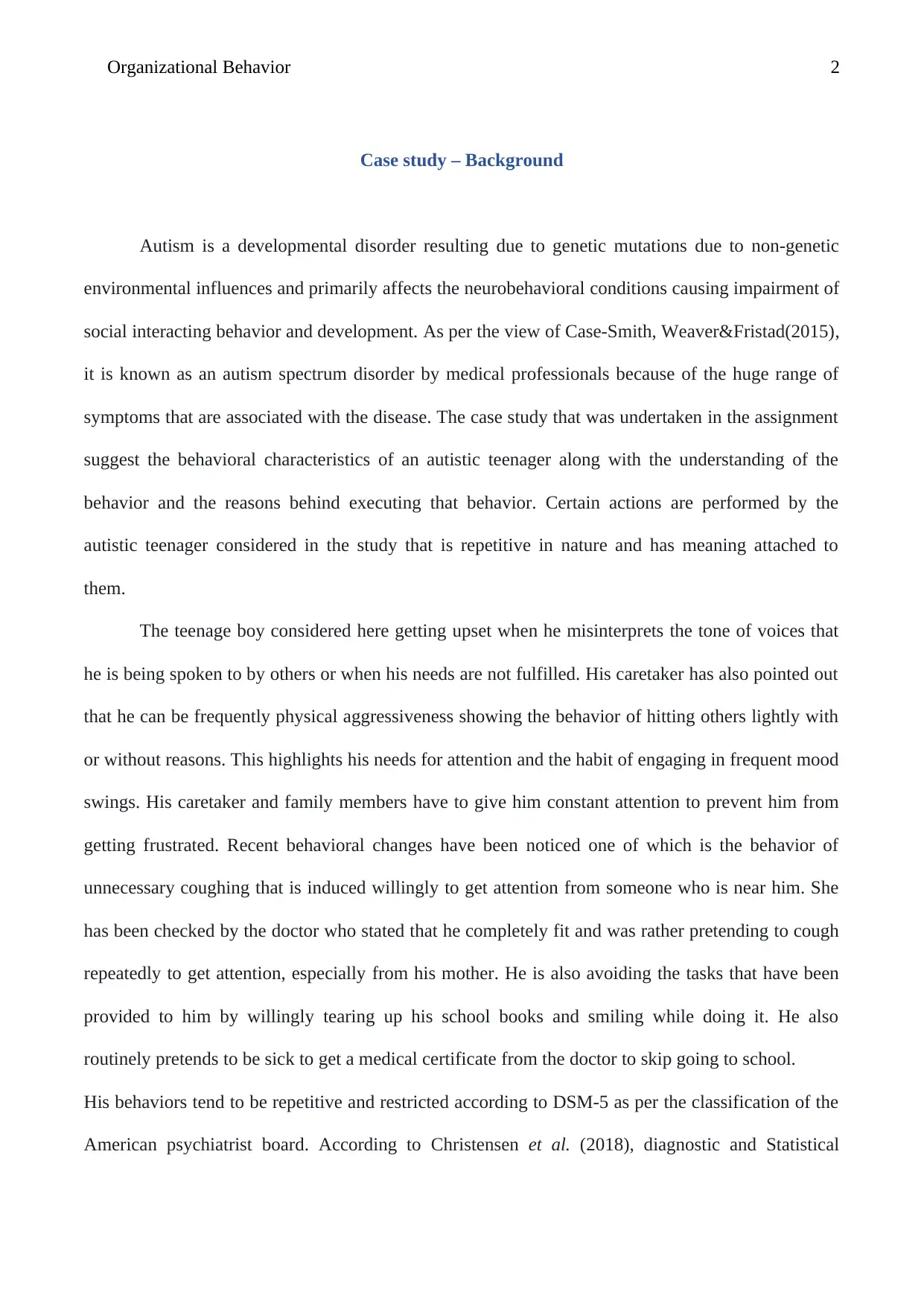
Organizational Behavior 2
Case study – Background
Autism is a developmental disorder resulting due to genetic mutations due to non-genetic
environmental influences and primarily affects the neurobehavioral conditions causing impairment of
social interacting behavior and development. As per the view of Case-Smith, Weaver&Fristad(2015),
it is known as an autism spectrum disorder by medical professionals because of the huge range of
symptoms that are associated with the disease. The case study that was undertaken in the assignment
suggest the behavioral characteristics of an autistic teenager along with the understanding of the
behavior and the reasons behind executing that behavior. Certain actions are performed by the
autistic teenager considered in the study that is repetitive in nature and has meaning attached to
them.
The teenage boy considered here getting upset when he misinterprets the tone of voices that
he is being spoken to by others or when his needs are not fulfilled. His caretaker has also pointed out
that he can be frequently physical aggressiveness showing the behavior of hitting others lightly with
or without reasons. This highlights his needs for attention and the habit of engaging in frequent mood
swings. His caretaker and family members have to give him constant attention to prevent him from
getting frustrated. Recent behavioral changes have been noticed one of which is the behavior of
unnecessary coughing that is induced willingly to get attention from someone who is near him. She
has been checked by the doctor who stated that he completely fit and was rather pretending to cough
repeatedly to get attention, especially from his mother. He is also avoiding the tasks that have been
provided to him by willingly tearing up his school books and smiling while doing it. He also
routinely pretends to be sick to get a medical certificate from the doctor to skip going to school.
His behaviors tend to be repetitive and restricted according to DSM-5 as per the classification of the
American psychiatrist board. According to Christensen et al. (2018), diagnostic and Statistical
Case study – Background
Autism is a developmental disorder resulting due to genetic mutations due to non-genetic
environmental influences and primarily affects the neurobehavioral conditions causing impairment of
social interacting behavior and development. As per the view of Case-Smith, Weaver&Fristad(2015),
it is known as an autism spectrum disorder by medical professionals because of the huge range of
symptoms that are associated with the disease. The case study that was undertaken in the assignment
suggest the behavioral characteristics of an autistic teenager along with the understanding of the
behavior and the reasons behind executing that behavior. Certain actions are performed by the
autistic teenager considered in the study that is repetitive in nature and has meaning attached to
them.
The teenage boy considered here getting upset when he misinterprets the tone of voices that
he is being spoken to by others or when his needs are not fulfilled. His caretaker has also pointed out
that he can be frequently physical aggressiveness showing the behavior of hitting others lightly with
or without reasons. This highlights his needs for attention and the habit of engaging in frequent mood
swings. His caretaker and family members have to give him constant attention to prevent him from
getting frustrated. Recent behavioral changes have been noticed one of which is the behavior of
unnecessary coughing that is induced willingly to get attention from someone who is near him. She
has been checked by the doctor who stated that he completely fit and was rather pretending to cough
repeatedly to get attention, especially from his mother. He is also avoiding the tasks that have been
provided to him by willingly tearing up his school books and smiling while doing it. He also
routinely pretends to be sick to get a medical certificate from the doctor to skip going to school.
His behaviors tend to be repetitive and restricted according to DSM-5 as per the classification of the
American psychiatrist board. According to Christensen et al. (2018), diagnostic and Statistical
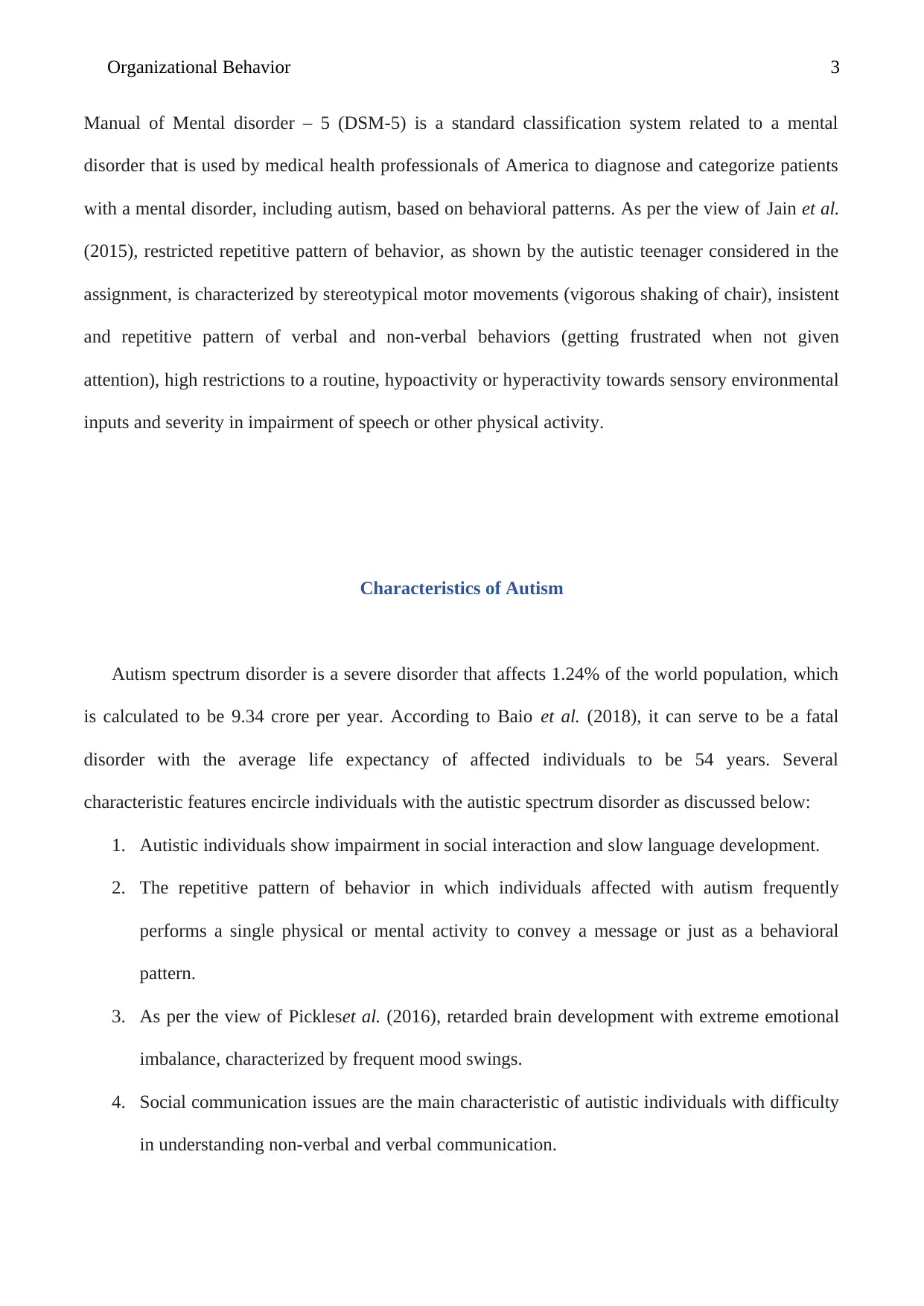
Organizational Behavior 3
Manual of Mental disorder – 5 (DSM-5) is a standard classification system related to a mental
disorder that is used by medical health professionals of America to diagnose and categorize patients
with a mental disorder, including autism, based on behavioral patterns. As per the view of Jain et al.
(2015), restricted repetitive pattern of behavior, as shown by the autistic teenager considered in the
assignment, is characterized by stereotypical motor movements (vigorous shaking of chair), insistent
and repetitive pattern of verbal and non-verbal behaviors (getting frustrated when not given
attention), high restrictions to a routine, hypoactivity or hyperactivity towards sensory environmental
inputs and severity in impairment of speech or other physical activity.
Characteristics of Autism
Autism spectrum disorder is a severe disorder that affects 1.24% of the world population, which
is calculated to be 9.34 crore per year. According to Baio et al. (2018), it can serve to be a fatal
disorder with the average life expectancy of affected individuals to be 54 years. Several
characteristic features encircle individuals with the autistic spectrum disorder as discussed below:
1. Autistic individuals show impairment in social interaction and slow language development.
2. The repetitive pattern of behavior in which individuals affected with autism frequently
performs a single physical or mental activity to convey a message or just as a behavioral
pattern.
3. As per the view of Pickleset al. (2016), retarded brain development with extreme emotional
imbalance, characterized by frequent mood swings.
4. Social communication issues are the main characteristic of autistic individuals with difficulty
in understanding non-verbal and verbal communication.
Manual of Mental disorder – 5 (DSM-5) is a standard classification system related to a mental
disorder that is used by medical health professionals of America to diagnose and categorize patients
with a mental disorder, including autism, based on behavioral patterns. As per the view of Jain et al.
(2015), restricted repetitive pattern of behavior, as shown by the autistic teenager considered in the
assignment, is characterized by stereotypical motor movements (vigorous shaking of chair), insistent
and repetitive pattern of verbal and non-verbal behaviors (getting frustrated when not given
attention), high restrictions to a routine, hypoactivity or hyperactivity towards sensory environmental
inputs and severity in impairment of speech or other physical activity.
Characteristics of Autism
Autism spectrum disorder is a severe disorder that affects 1.24% of the world population, which
is calculated to be 9.34 crore per year. According to Baio et al. (2018), it can serve to be a fatal
disorder with the average life expectancy of affected individuals to be 54 years. Several
characteristic features encircle individuals with the autistic spectrum disorder as discussed below:
1. Autistic individuals show impairment in social interaction and slow language development.
2. The repetitive pattern of behavior in which individuals affected with autism frequently
performs a single physical or mental activity to convey a message or just as a behavioral
pattern.
3. As per the view of Pickleset al. (2016), retarded brain development with extreme emotional
imbalance, characterized by frequent mood swings.
4. Social communication issues are the main characteristic of autistic individuals with difficulty
in understanding non-verbal and verbal communication.
⊘ This is a preview!⊘
Do you want full access?
Subscribe today to unlock all pages.

Trusted by 1+ million students worldwide
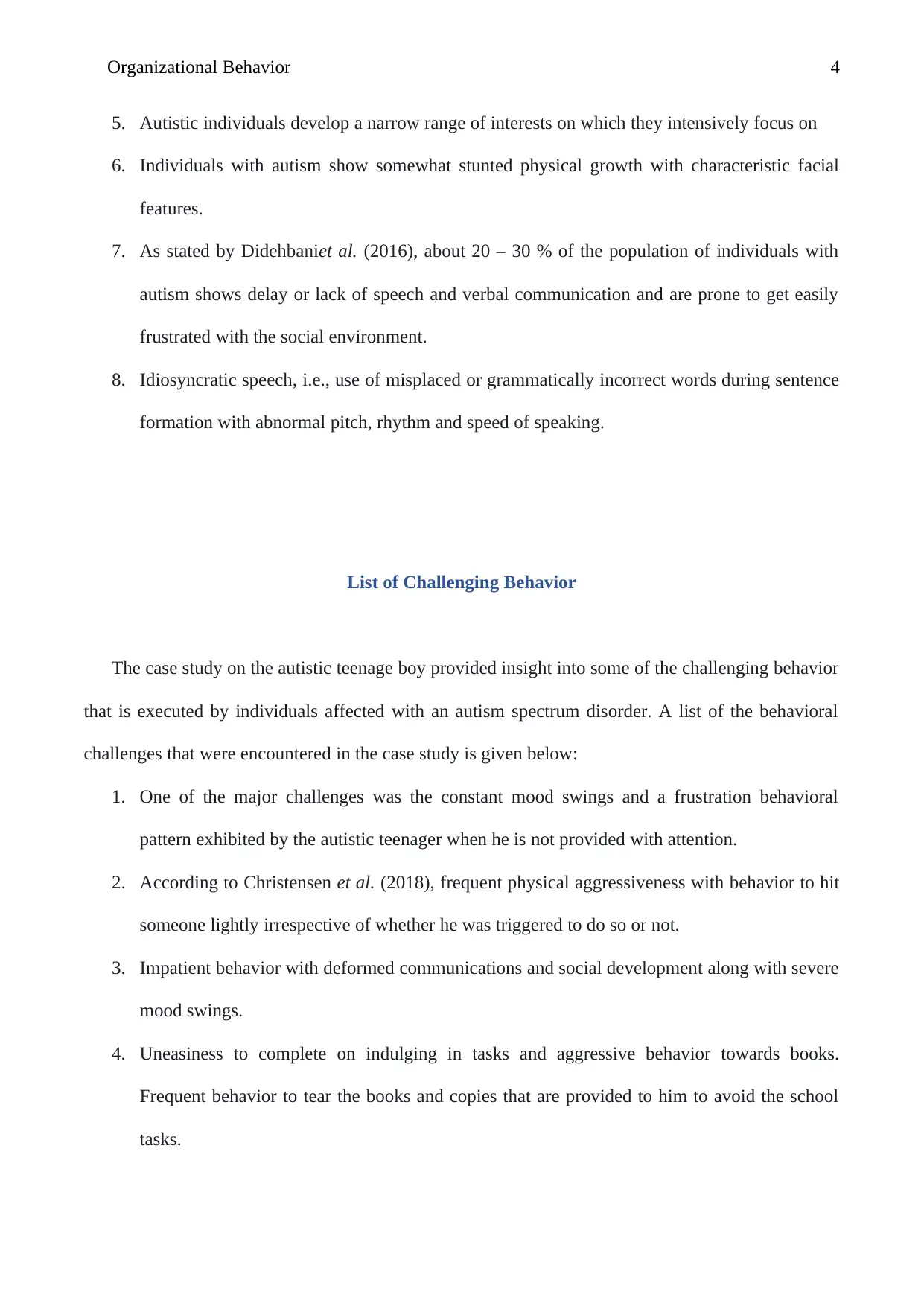
Organizational Behavior 4
5. Autistic individuals develop a narrow range of interests on which they intensively focus on
6. Individuals with autism show somewhat stunted physical growth with characteristic facial
features.
7. As stated by Didehbaniet al. (2016), about 20 – 30 % of the population of individuals with
autism shows delay or lack of speech and verbal communication and are prone to get easily
frustrated with the social environment.
8. Idiosyncratic speech, i.e., use of misplaced or grammatically incorrect words during sentence
formation with abnormal pitch, rhythm and speed of speaking.
List of Challenging Behavior
The case study on the autistic teenage boy provided insight into some of the challenging behavior
that is executed by individuals affected with an autism spectrum disorder. A list of the behavioral
challenges that were encountered in the case study is given below:
1. One of the major challenges was the constant mood swings and a frustration behavioral
pattern exhibited by the autistic teenager when he is not provided with attention.
2. According to Christensen et al. (2018), frequent physical aggressiveness with behavior to hit
someone lightly irrespective of whether he was triggered to do so or not.
3. Impatient behavior with deformed communications and social development along with severe
mood swings.
4. Uneasiness to complete on indulging in tasks and aggressive behavior towards books.
Frequent behavior to tear the books and copies that are provided to him to avoid the school
tasks.
5. Autistic individuals develop a narrow range of interests on which they intensively focus on
6. Individuals with autism show somewhat stunted physical growth with characteristic facial
features.
7. As stated by Didehbaniet al. (2016), about 20 – 30 % of the population of individuals with
autism shows delay or lack of speech and verbal communication and are prone to get easily
frustrated with the social environment.
8. Idiosyncratic speech, i.e., use of misplaced or grammatically incorrect words during sentence
formation with abnormal pitch, rhythm and speed of speaking.
List of Challenging Behavior
The case study on the autistic teenage boy provided insight into some of the challenging behavior
that is executed by individuals affected with an autism spectrum disorder. A list of the behavioral
challenges that were encountered in the case study is given below:
1. One of the major challenges was the constant mood swings and a frustration behavioral
pattern exhibited by the autistic teenager when he is not provided with attention.
2. According to Christensen et al. (2018), frequent physical aggressiveness with behavior to hit
someone lightly irrespective of whether he was triggered to do so or not.
3. Impatient behavior with deformed communications and social development along with severe
mood swings.
4. Uneasiness to complete on indulging in tasks and aggressive behavior towards books.
Frequent behavior to tear the books and copies that are provided to him to avoid the school
tasks.
Paraphrase This Document
Need a fresh take? Get an instant paraphrase of this document with our AI Paraphraser
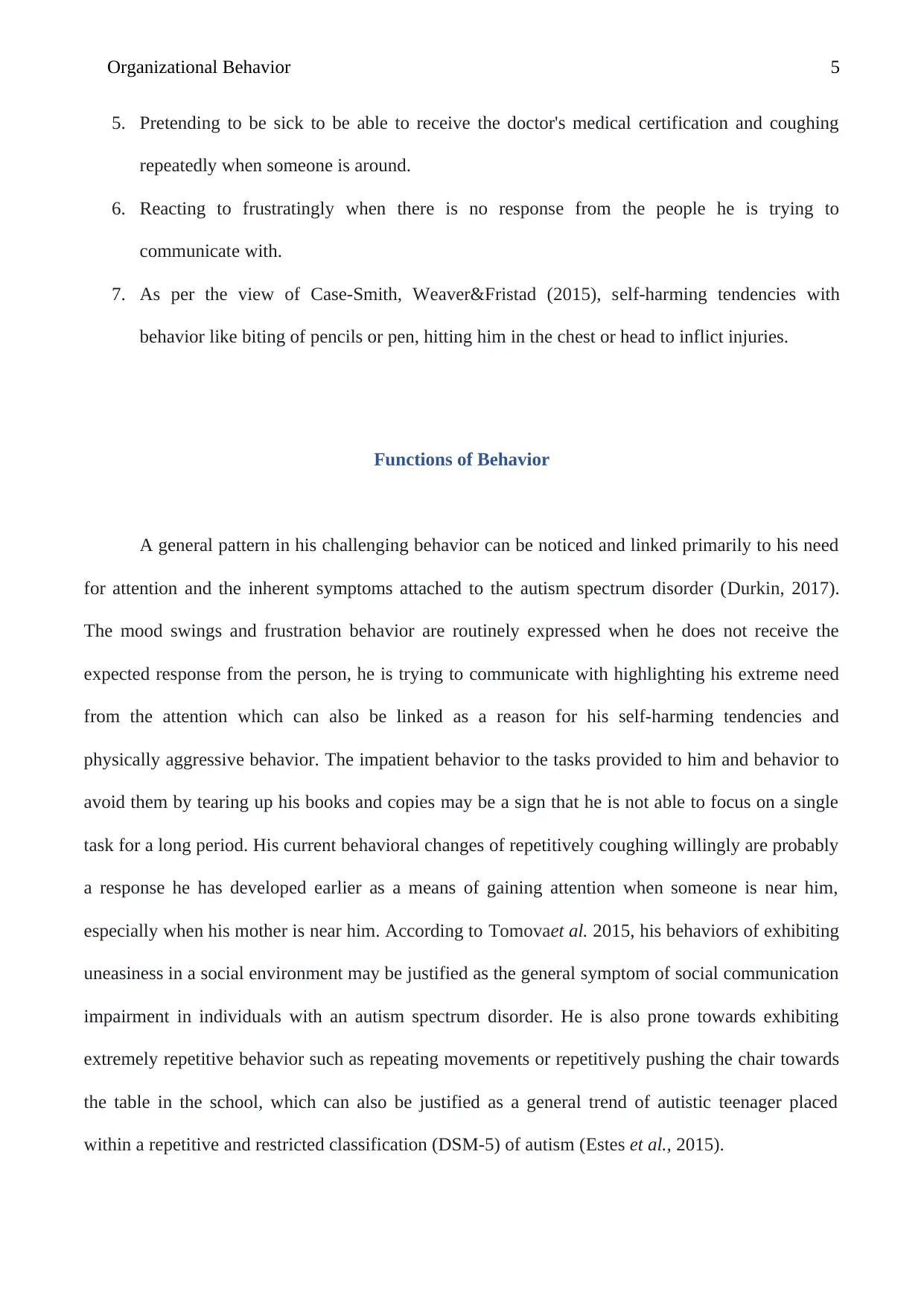
Organizational Behavior 5
5. Pretending to be sick to be able to receive the doctor's medical certification and coughing
repeatedly when someone is around.
6. Reacting to frustratingly when there is no response from the people he is trying to
communicate with.
7. As per the view of Case-Smith, Weaver&Fristad (2015), self-harming tendencies with
behavior like biting of pencils or pen, hitting him in the chest or head to inflict injuries.
Functions of Behavior
A general pattern in his challenging behavior can be noticed and linked primarily to his need
for attention and the inherent symptoms attached to the autism spectrum disorder (Durkin, 2017).
The mood swings and frustration behavior are routinely expressed when he does not receive the
expected response from the person, he is trying to communicate with highlighting his extreme need
from the attention which can also be linked as a reason for his self-harming tendencies and
physically aggressive behavior. The impatient behavior to the tasks provided to him and behavior to
avoid them by tearing up his books and copies may be a sign that he is not able to focus on a single
task for a long period. His current behavioral changes of repetitively coughing willingly are probably
a response he has developed earlier as a means of gaining attention when someone is near him,
especially when his mother is near him. According to Tomovaet al. 2015, his behaviors of exhibiting
uneasiness in a social environment may be justified as the general symptom of social communication
impairment in individuals with an autism spectrum disorder. He is also prone towards exhibiting
extremely repetitive behavior such as repeating movements or repetitively pushing the chair towards
the table in the school, which can also be justified as a general trend of autistic teenager placed
within a repetitive and restricted classification (DSM-5) of autism (Estes et al., 2015).
5. Pretending to be sick to be able to receive the doctor's medical certification and coughing
repeatedly when someone is around.
6. Reacting to frustratingly when there is no response from the people he is trying to
communicate with.
7. As per the view of Case-Smith, Weaver&Fristad (2015), self-harming tendencies with
behavior like biting of pencils or pen, hitting him in the chest or head to inflict injuries.
Functions of Behavior
A general pattern in his challenging behavior can be noticed and linked primarily to his need
for attention and the inherent symptoms attached to the autism spectrum disorder (Durkin, 2017).
The mood swings and frustration behavior are routinely expressed when he does not receive the
expected response from the person, he is trying to communicate with highlighting his extreme need
from the attention which can also be linked as a reason for his self-harming tendencies and
physically aggressive behavior. The impatient behavior to the tasks provided to him and behavior to
avoid them by tearing up his books and copies may be a sign that he is not able to focus on a single
task for a long period. His current behavioral changes of repetitively coughing willingly are probably
a response he has developed earlier as a means of gaining attention when someone is near him,
especially when his mother is near him. According to Tomovaet al. 2015, his behaviors of exhibiting
uneasiness in a social environment may be justified as the general symptom of social communication
impairment in individuals with an autism spectrum disorder. He is also prone towards exhibiting
extremely repetitive behavior such as repeating movements or repetitively pushing the chair towards
the table in the school, which can also be justified as a general trend of autistic teenager placed
within a repetitive and restricted classification (DSM-5) of autism (Estes et al., 2015).
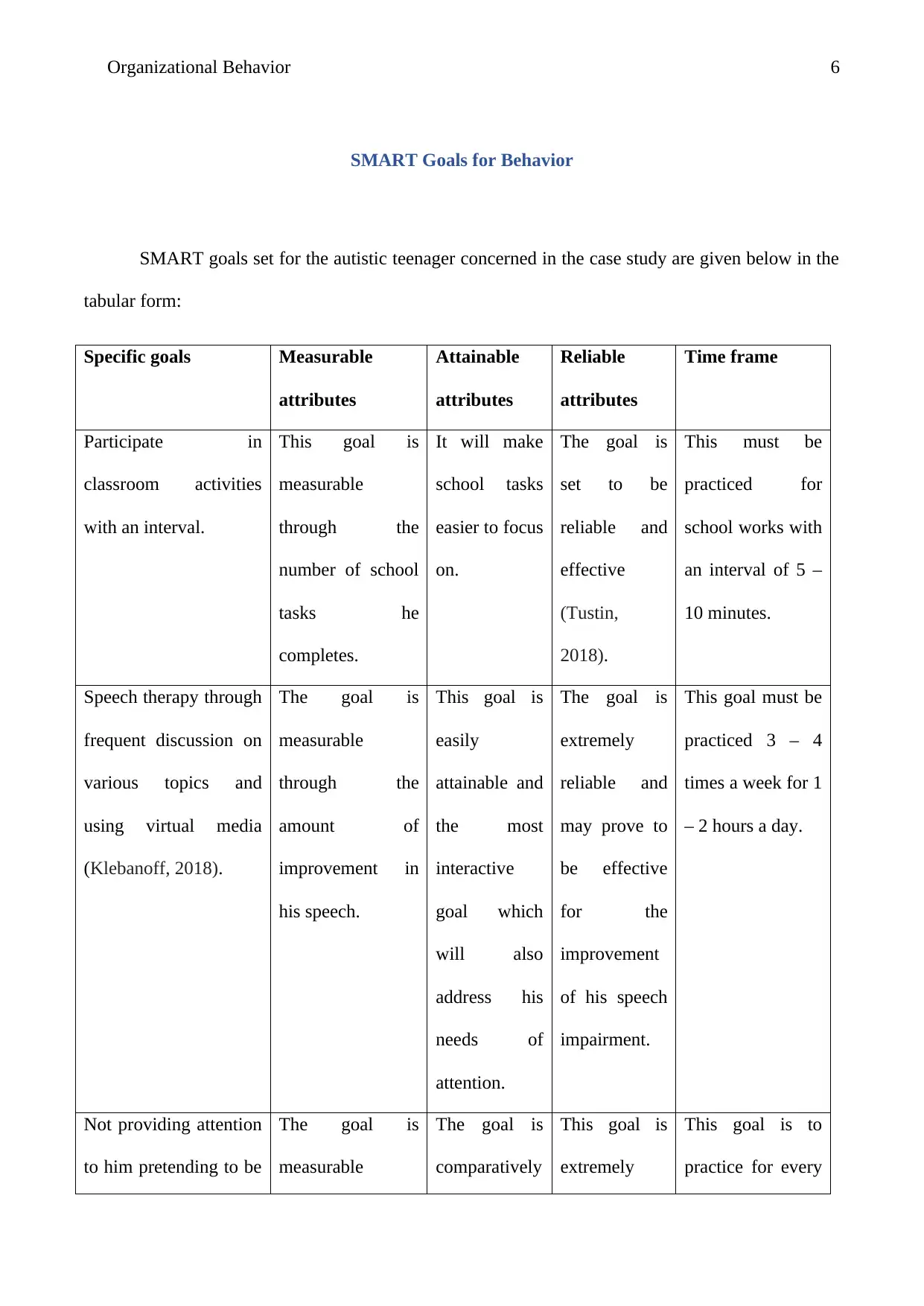
Organizational Behavior 6
SMART Goals for Behavior
SMART goals set for the autistic teenager concerned in the case study are given below in the
tabular form:
Specific goals Measurable
attributes
Attainable
attributes
Reliable
attributes
Time frame
Participate in
classroom activities
with an interval.
This goal is
measurable
through the
number of school
tasks he
completes.
It will make
school tasks
easier to focus
on.
The goal is
set to be
reliable and
effective
(Tustin,
2018).
This must be
practiced for
school works with
an interval of 5 –
10 minutes.
Speech therapy through
frequent discussion on
various topics and
using virtual media
(Klebanoff, 2018).
The goal is
measurable
through the
amount of
improvement in
his speech.
This goal is
easily
attainable and
the most
interactive
goal which
will also
address his
needs of
attention.
The goal is
extremely
reliable and
may prove to
be effective
for the
improvement
of his speech
impairment.
This goal must be
practiced 3 – 4
times a week for 1
– 2 hours a day.
Not providing attention
to him pretending to be
The goal is
measurable
The goal is
comparatively
This goal is
extremely
This goal is to
practice for every
SMART Goals for Behavior
SMART goals set for the autistic teenager concerned in the case study are given below in the
tabular form:
Specific goals Measurable
attributes
Attainable
attributes
Reliable
attributes
Time frame
Participate in
classroom activities
with an interval.
This goal is
measurable
through the
number of school
tasks he
completes.
It will make
school tasks
easier to focus
on.
The goal is
set to be
reliable and
effective
(Tustin,
2018).
This must be
practiced for
school works with
an interval of 5 –
10 minutes.
Speech therapy through
frequent discussion on
various topics and
using virtual media
(Klebanoff, 2018).
The goal is
measurable
through the
amount of
improvement in
his speech.
This goal is
easily
attainable and
the most
interactive
goal which
will also
address his
needs of
attention.
The goal is
extremely
reliable and
may prove to
be effective
for the
improvement
of his speech
impairment.
This goal must be
practiced 3 – 4
times a week for 1
– 2 hours a day.
Not providing attention
to him pretending to be
The goal is
measurable
The goal is
comparatively
This goal is
extremely
This goal is to
practice for every
⊘ This is a preview!⊘
Do you want full access?
Subscribe today to unlock all pages.

Trusted by 1+ million students worldwide
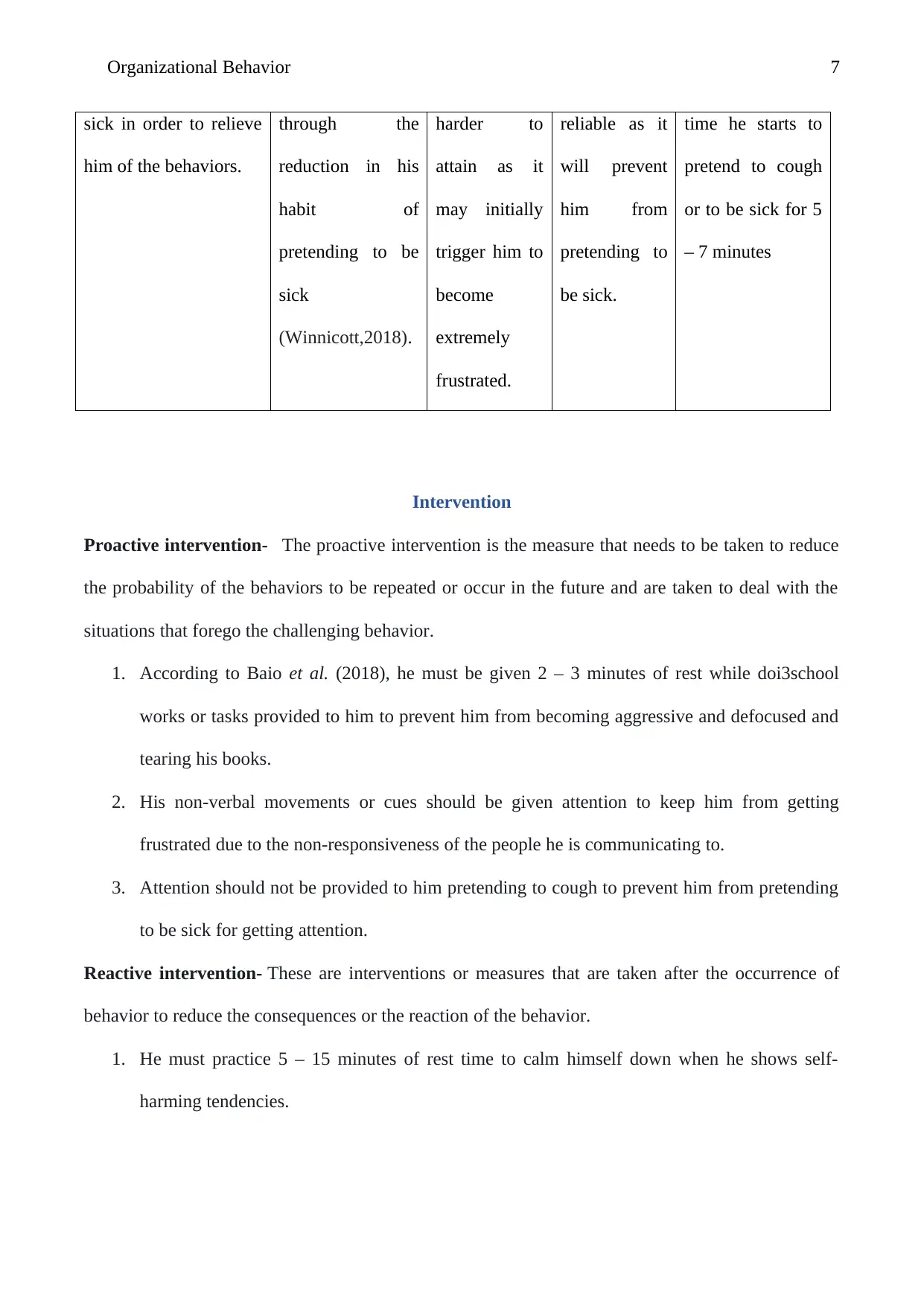
Organizational Behavior 7
sick in order to relieve
him of the behaviors.
through the
reduction in his
habit of
pretending to be
sick
(Winnicott,2018).
harder to
attain as it
may initially
trigger him to
become
extremely
frustrated.
reliable as it
will prevent
him from
pretending to
be sick.
time he starts to
pretend to cough
or to be sick for 5
– 7 minutes
Intervention
Proactive intervention- The proactive intervention is the measure that needs to be taken to reduce
the probability of the behaviors to be repeated or occur in the future and are taken to deal with the
situations that forego the challenging behavior.
1. According to Baio et al. (2018), he must be given 2 – 3 minutes of rest while doi3school
works or tasks provided to him to prevent him from becoming aggressive and defocused and
tearing his books.
2. His non-verbal movements or cues should be given attention to keep him from getting
frustrated due to the non-responsiveness of the people he is communicating to.
3. Attention should not be provided to him pretending to cough to prevent him from pretending
to be sick for getting attention.
Reactive intervention- These are interventions or measures that are taken after the occurrence of
behavior to reduce the consequences or the reaction of the behavior.
1. He must practice 5 – 15 minutes of rest time to calm himself down when he shows self-
harming tendencies.
sick in order to relieve
him of the behaviors.
through the
reduction in his
habit of
pretending to be
sick
(Winnicott,2018).
harder to
attain as it
may initially
trigger him to
become
extremely
frustrated.
reliable as it
will prevent
him from
pretending to
be sick.
time he starts to
pretend to cough
or to be sick for 5
– 7 minutes
Intervention
Proactive intervention- The proactive intervention is the measure that needs to be taken to reduce
the probability of the behaviors to be repeated or occur in the future and are taken to deal with the
situations that forego the challenging behavior.
1. According to Baio et al. (2018), he must be given 2 – 3 minutes of rest while doi3school
works or tasks provided to him to prevent him from becoming aggressive and defocused and
tearing his books.
2. His non-verbal movements or cues should be given attention to keep him from getting
frustrated due to the non-responsiveness of the people he is communicating to.
3. Attention should not be provided to him pretending to cough to prevent him from pretending
to be sick for getting attention.
Reactive intervention- These are interventions or measures that are taken after the occurrence of
behavior to reduce the consequences or the reaction of the behavior.
1. He must practice 5 – 15 minutes of rest time to calm himself down when he shows self-
harming tendencies.
Paraphrase This Document
Need a fresh take? Get an instant paraphrase of this document with our AI Paraphraser
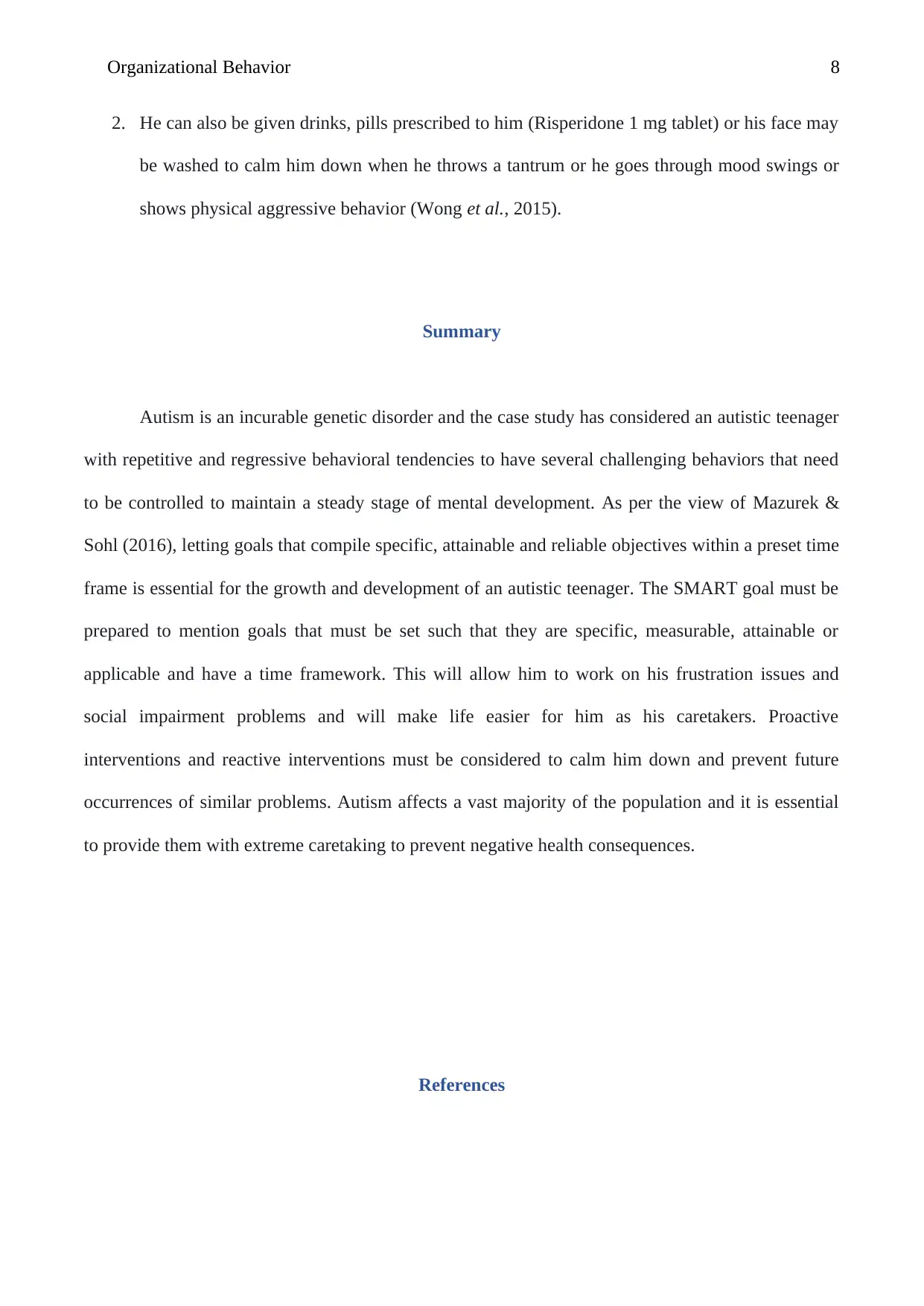
Organizational Behavior 8
2. He can also be given drinks, pills prescribed to him (Risperidone 1 mg tablet) or his face may
be washed to calm him down when he throws a tantrum or he goes through mood swings or
shows physical aggressive behavior (Wong et al., 2015).
Summary
Autism is an incurable genetic disorder and the case study has considered an autistic teenager
with repetitive and regressive behavioral tendencies to have several challenging behaviors that need
to be controlled to maintain a steady stage of mental development. As per the view of Mazurek &
Sohl (2016), letting goals that compile specific, attainable and reliable objectives within a preset time
frame is essential for the growth and development of an autistic teenager. The SMART goal must be
prepared to mention goals that must be set such that they are specific, measurable, attainable or
applicable and have a time framework. This will allow him to work on his frustration issues and
social impairment problems and will make life easier for him as his caretakers. Proactive
interventions and reactive interventions must be considered to calm him down and prevent future
occurrences of similar problems. Autism affects a vast majority of the population and it is essential
to provide them with extreme caretaking to prevent negative health consequences.
References
2. He can also be given drinks, pills prescribed to him (Risperidone 1 mg tablet) or his face may
be washed to calm him down when he throws a tantrum or he goes through mood swings or
shows physical aggressive behavior (Wong et al., 2015).
Summary
Autism is an incurable genetic disorder and the case study has considered an autistic teenager
with repetitive and regressive behavioral tendencies to have several challenging behaviors that need
to be controlled to maintain a steady stage of mental development. As per the view of Mazurek &
Sohl (2016), letting goals that compile specific, attainable and reliable objectives within a preset time
frame is essential for the growth and development of an autistic teenager. The SMART goal must be
prepared to mention goals that must be set such that they are specific, measurable, attainable or
applicable and have a time framework. This will allow him to work on his frustration issues and
social impairment problems and will make life easier for him as his caretakers. Proactive
interventions and reactive interventions must be considered to calm him down and prevent future
occurrences of similar problems. Autism affects a vast majority of the population and it is essential
to provide them with extreme caretaking to prevent negative health consequences.
References
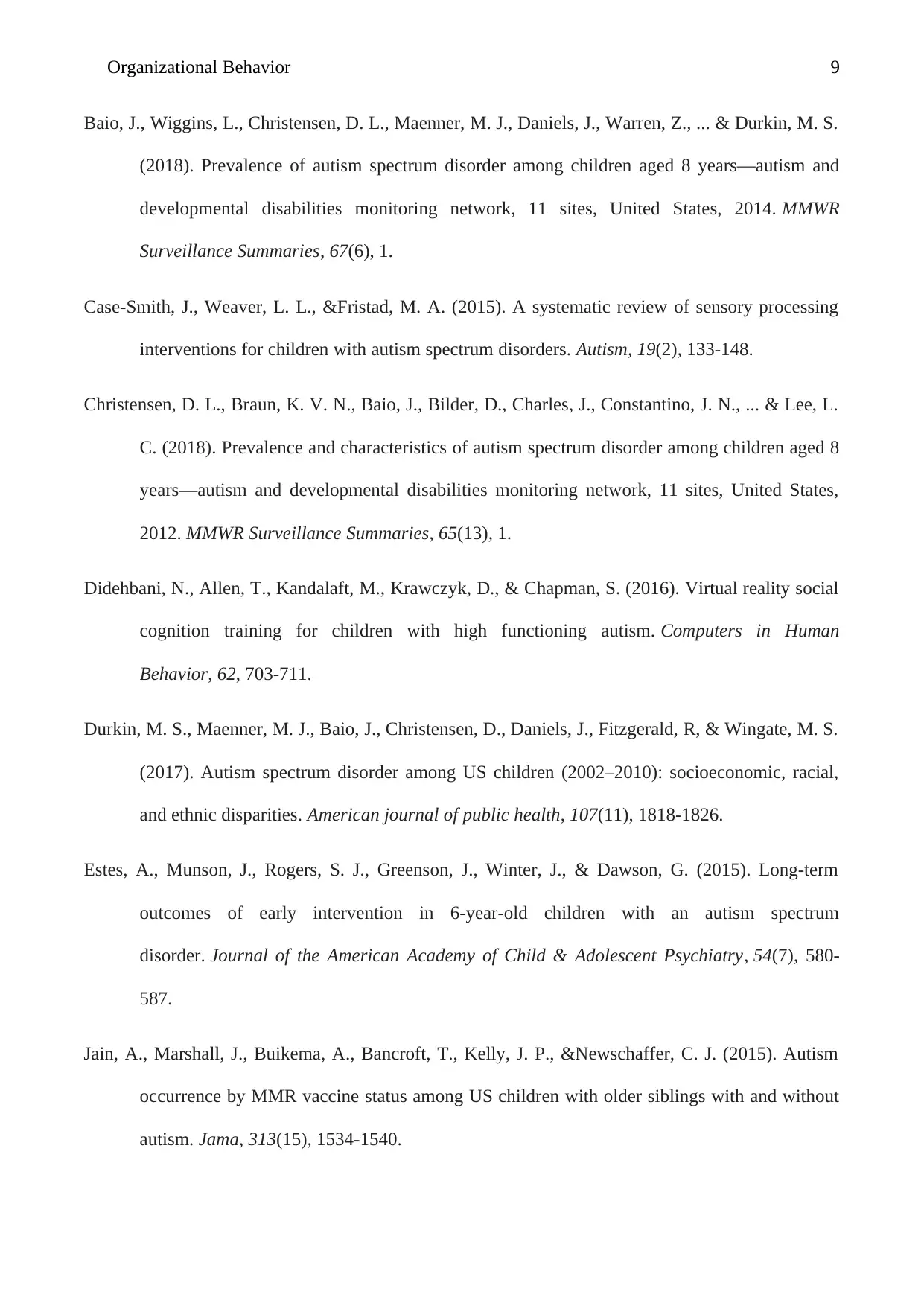
Organizational Behavior 9
Baio, J., Wiggins, L., Christensen, D. L., Maenner, M. J., Daniels, J., Warren, Z., ... & Durkin, M. S.
(2018). Prevalence of autism spectrum disorder among children aged 8 years—autism and
developmental disabilities monitoring network, 11 sites, United States, 2014. MMWR
Surveillance Summaries, 67(6), 1.
Case-Smith, J., Weaver, L. L., &Fristad, M. A. (2015). A systematic review of sensory processing
interventions for children with autism spectrum disorders. Autism, 19(2), 133-148.
Christensen, D. L., Braun, K. V. N., Baio, J., Bilder, D., Charles, J., Constantino, J. N., ... & Lee, L.
C. (2018). Prevalence and characteristics of autism spectrum disorder among children aged 8
years—autism and developmental disabilities monitoring network, 11 sites, United States,
2012. MMWR Surveillance Summaries, 65(13), 1.
Didehbani, N., Allen, T., Kandalaft, M., Krawczyk, D., & Chapman, S. (2016). Virtual reality social
cognition training for children with high functioning autism. Computers in Human
Behavior, 62, 703-711.
Durkin, M. S., Maenner, M. J., Baio, J., Christensen, D., Daniels, J., Fitzgerald, R, & Wingate, M. S.
(2017). Autism spectrum disorder among US children (2002–2010): socioeconomic, racial,
and ethnic disparities. American journal of public health, 107(11), 1818-1826.
Estes, A., Munson, J., Rogers, S. J., Greenson, J., Winter, J., & Dawson, G. (2015). Long-term
outcomes of early intervention in 6-year-old children with an autism spectrum
disorder. Journal of the American Academy of Child & Adolescent Psychiatry, 54(7), 580-
587.
Jain, A., Marshall, J., Buikema, A., Bancroft, T., Kelly, J. P., &Newschaffer, C. J. (2015). Autism
occurrence by MMR vaccine status among US children with older siblings with and without
autism. Jama, 313(15), 1534-1540.
Baio, J., Wiggins, L., Christensen, D. L., Maenner, M. J., Daniels, J., Warren, Z., ... & Durkin, M. S.
(2018). Prevalence of autism spectrum disorder among children aged 8 years—autism and
developmental disabilities monitoring network, 11 sites, United States, 2014. MMWR
Surveillance Summaries, 67(6), 1.
Case-Smith, J., Weaver, L. L., &Fristad, M. A. (2015). A systematic review of sensory processing
interventions for children with autism spectrum disorders. Autism, 19(2), 133-148.
Christensen, D. L., Braun, K. V. N., Baio, J., Bilder, D., Charles, J., Constantino, J. N., ... & Lee, L.
C. (2018). Prevalence and characteristics of autism spectrum disorder among children aged 8
years—autism and developmental disabilities monitoring network, 11 sites, United States,
2012. MMWR Surveillance Summaries, 65(13), 1.
Didehbani, N., Allen, T., Kandalaft, M., Krawczyk, D., & Chapman, S. (2016). Virtual reality social
cognition training for children with high functioning autism. Computers in Human
Behavior, 62, 703-711.
Durkin, M. S., Maenner, M. J., Baio, J., Christensen, D., Daniels, J., Fitzgerald, R, & Wingate, M. S.
(2017). Autism spectrum disorder among US children (2002–2010): socioeconomic, racial,
and ethnic disparities. American journal of public health, 107(11), 1818-1826.
Estes, A., Munson, J., Rogers, S. J., Greenson, J., Winter, J., & Dawson, G. (2015). Long-term
outcomes of early intervention in 6-year-old children with an autism spectrum
disorder. Journal of the American Academy of Child & Adolescent Psychiatry, 54(7), 580-
587.
Jain, A., Marshall, J., Buikema, A., Bancroft, T., Kelly, J. P., &Newschaffer, C. J. (2015). Autism
occurrence by MMR vaccine status among US children with older siblings with and without
autism. Jama, 313(15), 1534-1540.
⊘ This is a preview!⊘
Do you want full access?
Subscribe today to unlock all pages.

Trusted by 1+ million students worldwide
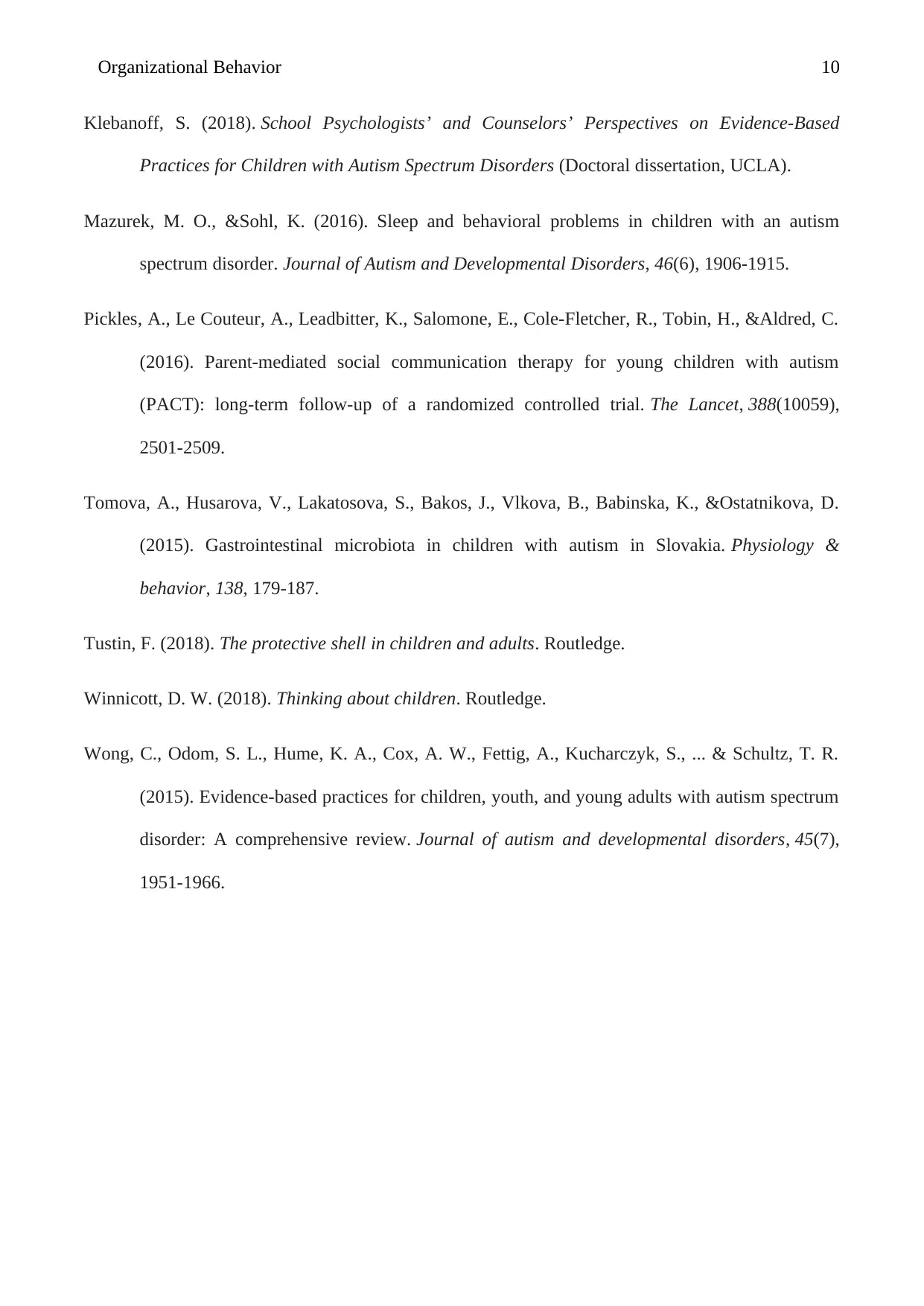
Organizational Behavior 10
Klebanoff, S. (2018). School Psychologists’ and Counselors’ Perspectives on Evidence-Based
Practices for Children with Autism Spectrum Disorders (Doctoral dissertation, UCLA).
Mazurek, M. O., &Sohl, K. (2016). Sleep and behavioral problems in children with an autism
spectrum disorder. Journal of Autism and Developmental Disorders, 46(6), 1906-1915.
Pickles, A., Le Couteur, A., Leadbitter, K., Salomone, E., Cole-Fletcher, R., Tobin, H., &Aldred, C.
(2016). Parent-mediated social communication therapy for young children with autism
(PACT): long-term follow-up of a randomized controlled trial. The Lancet, 388(10059),
2501-2509.
Tomova, A., Husarova, V., Lakatosova, S., Bakos, J., Vlkova, B., Babinska, K., &Ostatnikova, D.
(2015). Gastrointestinal microbiota in children with autism in Slovakia. Physiology &
behavior, 138, 179-187.
Tustin, F. (2018). The protective shell in children and adults. Routledge.
Winnicott, D. W. (2018). Thinking about children. Routledge.
Wong, C., Odom, S. L., Hume, K. A., Cox, A. W., Fettig, A., Kucharczyk, S., ... & Schultz, T. R.
(2015). Evidence-based practices for children, youth, and young adults with autism spectrum
disorder: A comprehensive review. Journal of autism and developmental disorders, 45(7),
1951-1966.
Klebanoff, S. (2018). School Psychologists’ and Counselors’ Perspectives on Evidence-Based
Practices for Children with Autism Spectrum Disorders (Doctoral dissertation, UCLA).
Mazurek, M. O., &Sohl, K. (2016). Sleep and behavioral problems in children with an autism
spectrum disorder. Journal of Autism and Developmental Disorders, 46(6), 1906-1915.
Pickles, A., Le Couteur, A., Leadbitter, K., Salomone, E., Cole-Fletcher, R., Tobin, H., &Aldred, C.
(2016). Parent-mediated social communication therapy for young children with autism
(PACT): long-term follow-up of a randomized controlled trial. The Lancet, 388(10059),
2501-2509.
Tomova, A., Husarova, V., Lakatosova, S., Bakos, J., Vlkova, B., Babinska, K., &Ostatnikova, D.
(2015). Gastrointestinal microbiota in children with autism in Slovakia. Physiology &
behavior, 138, 179-187.
Tustin, F. (2018). The protective shell in children and adults. Routledge.
Winnicott, D. W. (2018). Thinking about children. Routledge.
Wong, C., Odom, S. L., Hume, K. A., Cox, A. W., Fettig, A., Kucharczyk, S., ... & Schultz, T. R.
(2015). Evidence-based practices for children, youth, and young adults with autism spectrum
disorder: A comprehensive review. Journal of autism and developmental disorders, 45(7),
1951-1966.
1 out of 10
Related Documents
Your All-in-One AI-Powered Toolkit for Academic Success.
+13062052269
info@desklib.com
Available 24*7 on WhatsApp / Email
![[object Object]](/_next/static/media/star-bottom.7253800d.svg)
Unlock your academic potential
Copyright © 2020–2025 A2Z Services. All Rights Reserved. Developed and managed by ZUCOL.


